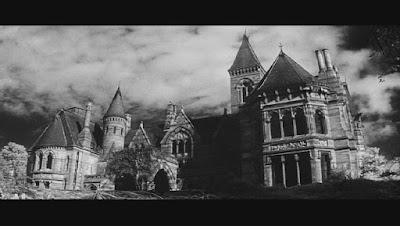It’s Halloween Season again and TV channels, movies, radio and much of the internet are paying tribute to this time by retelling the stories that entertain and scare us. The traditional cast of characters are all on display: witches, werewolves, vampires, ghosts, zombies and other deadundead players that make things go bump in the night. I like most of these but they don’t terrify me. Haunted homes come closer to the mark since the atavistic part of my brain gives credence to these tales. It’s easy to believe homes absorb the emotions of the residents they protect and impressions of the events they witnessed. Still, because this type of haunting make sense, in the end they really don’t really frighten me either. These are traumatized buildings with PTSD and it’s obvious they need therapy. However, there is a sub-group of the haunted house that doesn’t follow this pattern. These are the houses that go bad without reason or rhyme. These sentient, “born bad” buildings prey on inhabitants for their own malevolent reasons. There aren’t many novels that fit in this category but one of the greatest is The Haunting of Hill House by Shirley Jackson. It can make you distrust your own house.
The story starts simply enough. Eleanor Vance is a single woman in the twentieth century who has never had a life of her own. After childhood, she cared for a dying mother until her parent died; then she moved into her sister’s home. Eleanor has never had a job, or friends, and her family barely tolerates her. Because of a strange phenomena Eleanor experienced as a child, she’s been invited for a short stay at Hill House, an uninhabited country home. Dr. Montague, the man behind the invitation, thinks she can have an effect on the house.
An odd group of people have answered Dr. Montague’s invitation to stay, but Hill House is even odder. Everything in the house is off kilter, from the angle of the interior walls to the shades of color in each of the rooms. Because the wall angles are all distorted, the house isn’t laid out in a traditional way. Some rooms can only be accessed through other rooms, upper rooms don’t sit squarely over the lower ones and doors seem to close by themselves. Things disappear too easily in Hill House and voices come from unaccountable places but once there, Eleanor doesn’t want to leave – frightening as it is, Hill House is the first place where she’s given respect or kindness and she is loath to relinquish that treatment or her feeling of independence. Eventually, Eleanor has to choose between returning to her unhappy life of sanity or keeping an illusion of freedom by remaining in the hellish Hill House.

Hill House succeeds because it exploits our love of hearth and home to create its underlying horror. Home is our port of refuge, our shelter against the world. Whether it’s an apartment, a cottage or a sixty-room mansion, “home” is the place we can shed our defenses and simply be ourselves, vulnerable inside these constructed shells. This is why we describe houses in nurturing terms, the way we would describe caring parents. In this metaphor, the mortise and bricks of Hill House carry the DNA of a psychopath for as its author stated,
“No live organism can continue for long to exist sanely under conditions of absolute reality; even larks and katydids are supposed, by some, to dream. Hill House, not sane, stood by itself against its hills, holding darkness within; it had stood so for eighty years and might stand for eighty more. Within, walls continued upright, bricks met neatly, floors were firm, and doors were sensibly shut; silence lay steadily against the wood and stone of Hill House, and whatever walked there, walked alone.”
We expect our homes to be well constructed and quiet; we fantasize they are sentient and kind. In other words, we think of our homes the way we’d like to be thought of ourselves. That’s why homelessness is more than a financial calamity; it erodes identity and peace of mind. After you enjoy the Halloween festivities this year, think of how safe you feel in your home and say a prayer for those less fortunate. They walk among us every day, looking for shelter, love and respect. In their eagerness to find a home, some will disregard the obvious warning signs and enter distorted, unsafe spaces. When that happens, the spirit of Hill House will claim yet another victim, then continue to walk on alone.



No Comments
Comments are closed.